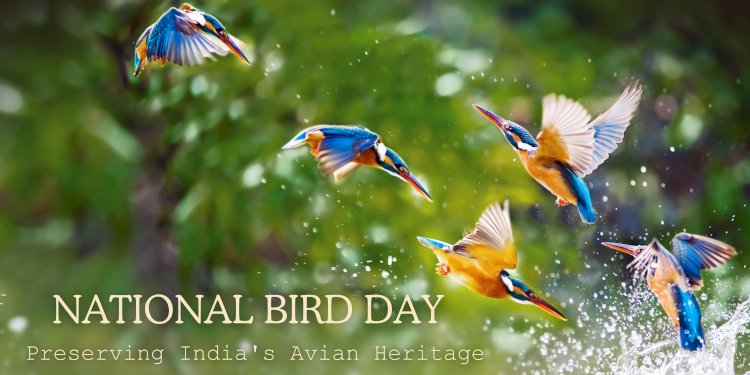National Bird Day: Preserving India's Avian Heritage
On National Bird Day, let's honour India's extraordinary avian diversity, spanning over 1,300 species inhabiting diverse ecosystems. From the iconic Indian Peafowl to the majestic Bengal Tiger, these birds play vital roles in maintaining ecological balance. However, threats like habitat loss and climate change necessitate urgent conservation. Conservation initiatives, including protected areas, community engagement, and research, aim to safeguard these winged wonders. Preserving birds is crucial not only for biodiversity but also for economic, cultural, and aesthetic reasons, as they contribute to ecosystems, local economies, and India's rich cultural tapestry. Let this day inspire a renewed commitment to ensuring a future where the skies of India continue to echo with the beauty and vitality of its avian inhabitants.
By Shreya Rajvanshi Gangal

National Bird Day is a momentous occasion to appreciate and acknowledge the rich avian biodiversity that graces the Indian subcontinent. India is a birdwatcher's paradise, boasting a staggering variety of bird species that captivate enthusiasts and scientists alike. This article delves into the diverse avian population of India, their habitats, the ongoing conservation efforts, and why it is crucial to conserve these feathered wonders.
Diversity of Birds in India:
India is home to over 1,300 species of birds, making it one of the most biodiverse countries on the planet. From the majestic Himalayas in the north to the tropical rainforests in the south, each region harbours its unique avian treasures. The diverse topography of India supports a range of habitats, including forests, grasslands, wetlands, and coastal areas, contributing to the vast array of bird species found across the country.
Notable Avian Species:
-
Indian Peafowl (Pavo cristatus): The national bird of India, renowned for its vibrant plumage and striking appearance, is a common sight in forests and rural landscapes.
-
Bengal Tiger (Haliaeetus leucogaster): Known for its distinctive white head and tail, this bird of prey is often spotted near water bodies, preying on fish.
-
Indian Roller (Coracias benghalensis): Recognized for its mesmerizing aerial acrobatics and vibrant hues, the Indian Roller is a common sight in open grasslands.
-
Sarus Crane (Antigone Antigone): As the world's tallest flying bird, the Sarus Crane is an iconic species often found in wetlands, symbolizing longevity and fidelity.
Conservation Efforts:
Despite the rich avian diversity, many bird species in India face threats due to habitat destruction, pollution, climate change, and poaching. Recognizing the importance of bird conservation, various initiatives and organizations are working tirelessly to protect and preserve these winged wonders.
-
Protected Areas and Wildlife Sanctuaries: India has established numerous national parks, wildlife sanctuaries, and bird sanctuaries to safeguard the habitats of various bird species.
-
Community-based Conservation Programs: Involving local communities in conservation efforts is crucial. Initiatives like community-led eco-tourism and awareness campaigns contribute to both bird protection and community livelihoods.
-
Research and Monitoring: Ongoing research projects and monitoring programs help scientists understand bird populations, migration patterns, and behaviour, enabling more effective conservation strategies.
Why Conserve Birds?
-
Biodiversity Maintenance: Birds play a vital role in maintaining ecological balance by controlling insect populations, pollinating plants, and dispersing seeds, contributing to the overall health of ecosystems.
-
Economic Significance: Birds contribute to the economy through activities such as birdwatching tourism, which generates revenue and employment opportunities, particularly in rural areas.
-
Indicators of Environmental Health: Birds are excellent indicators of environmental health. Changes in bird populations can signal shifts in ecosystems, alerting scientists to potential ecological imbalances.
-
Cultural and Aesthetic Value: Birds have profound cultural significance in India, appearing in mythology, folklore, and art. Additionally, their captivating colours, melodies, and behaviours add to the aesthetic appeal of natural landscapes.
Conclusion:
On National Bird Day, let us celebrate the diverse avian treasures of India and reflect on the importance of conserving these remarkable species. Through collective efforts, we can ensure a future where the skies of India remain filled with the vibrant colours and melodies of its magnificent birds, enriching our ecosystems and our lives.
What's Your Reaction?



















